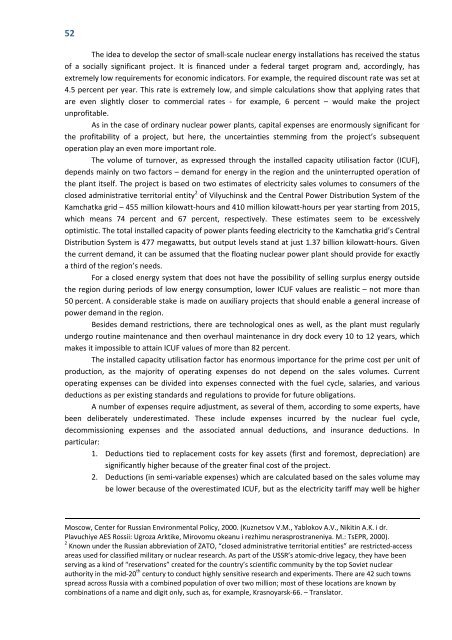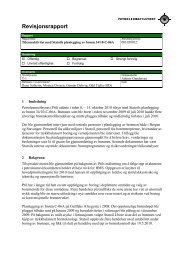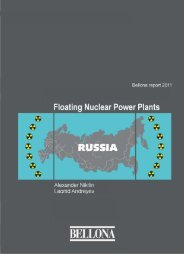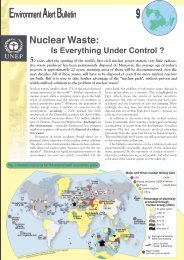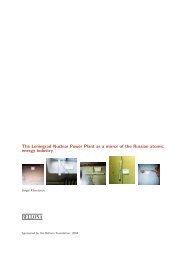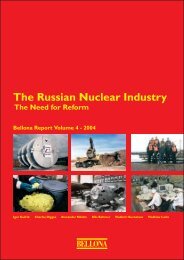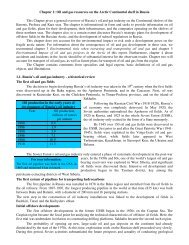52<strong>The</strong> idea to develop <strong>the</strong> sector <strong>of</strong> small‐scale nuclear energy installations has received <strong>the</strong> status<strong>of</strong> a socially significant project. It is financed under a federal target program and, accordingly, hasextremely low requirements for economic indicators. For example, <strong>the</strong> required discount rate was set at4.5 percent per year. This rate is extremely low, and simple calculations show that applying rates thatare even slightly closer to commercial rates ‐ for example, 6 percent – would make <strong>the</strong> projectunpr<strong>of</strong>itable.As in <strong>the</strong> case <strong>of</strong> ordinary nuclear power plants, capital expenses are enormously significant for<strong>the</strong> pr<strong>of</strong>itability <strong>of</strong> a project, but here, <strong>the</strong> uncertainties stemming from <strong>the</strong> project’s subsequentoperation play an even more important role.<strong>The</strong> volume <strong>of</strong> turnover, as expressed through <strong>the</strong> installed capacity utilisation factor (ICUF),depends mainly on two factors – demand for energy in <strong>the</strong> region and <strong>the</strong> uninterrupted operation <strong>of</strong><strong>the</strong> plant itself. <strong>The</strong> project is based on two estimates <strong>of</strong> electricity sales volumes to consumers <strong>of</strong> <strong>the</strong>closed administrative territorial entity 2 <strong>of</strong> Vilyuchinsk and <strong>the</strong> Central <strong>Power</strong> Distribution System <strong>of</strong> <strong>the</strong>Kamchatka grid – 455 million kilowatt‐hours and 410 million kilowatt‐hours per year starting from 2015,which means 74 percent and 67 percent, respectively. <strong>The</strong>se estimates seem to be excessivelyoptimistic. <strong>The</strong> total installed capacity <strong>of</strong> power plants feeding electricity to <strong>the</strong> Kamchatka grid’s CentralDistribution System is 477 megawatts, but output levels stand at just 1.37 billion kilowatt‐hours. Given<strong>the</strong> current demand, it can be assumed that <strong>the</strong> floating nuclear power plant should provide for exactlya third <strong>of</strong> <strong>the</strong> region’s needs.For a closed energy system that does not have <strong>the</strong> possibility <strong>of</strong> selling surplus energy outside<strong>the</strong> region during periods <strong>of</strong> low energy consumption, lower ICUF values are realistic – not more than50 percent. A considerable stake is made on auxiliary projects that should enable a general increase <strong>of</strong>power demand in <strong>the</strong> region.Besides demand restrictions, <strong>the</strong>re are technological ones as well, as <strong>the</strong> plant must regularlyundergo routine maintenance and <strong>the</strong>n overhaul maintenance in dry dock every 10 to 12 years, whichmakes it impossible to attain ICUF values <strong>of</strong> more than 82 percent.<strong>The</strong> installed capacity utilisation factor has enormous importance for <strong>the</strong> prime cost per unit <strong>of</strong>production, as <strong>the</strong> majority <strong>of</strong> operating expenses do not depend on <strong>the</strong> sales volumes. Currentoperating expenses can be divided into expenses connected with <strong>the</strong> fuel cycle, salaries, and variousdeductions as per existing standards and regulations to provide for future obligations.A number <strong>of</strong> expenses require adjustment, as several <strong>of</strong> <strong>the</strong>m, according to some experts, havebeen deliberately underestimated. <strong>The</strong>se include expenses incurred by <strong>the</strong> nuclear fuel cycle,decommissioning expenses and <strong>the</strong> associated annual deductions, and insurance deductions. Inparticular:1. Deductions tied to replacement costs for key assets (first and foremost, depreciation) aresignificantly higher because <strong>of</strong> <strong>the</strong> greater final cost <strong>of</strong> <strong>the</strong> project.2. Deductions (in semi‐variable expenses) which are calculated based on <strong>the</strong> sales volume maybe lower because <strong>of</strong> <strong>the</strong> overestimated ICUF, but as <strong>the</strong> electricity tariff may well be higherMoscow, Center for <strong>Russian</strong> Environmental Policy, 2000. (Kuznetsov V.M., Yablokov A.V., Nikitin A.K. i dr.Plavuchiye AES Rossii: Ugroza Arktike, Mirovomu okeanu i rezhimu nerasprostraneniya. М.: TsEPR, 2000).2 Known under <strong>the</strong> <strong>Russian</strong> abbreviation <strong>of</strong> ZATO, “closed administrative territorial entities” are restricted‐accessareas used for classified military or nuclear research. As part <strong>of</strong> <strong>the</strong> USSR’s atomic‐drive legacy, <strong>the</strong>y have beenserving as a kind <strong>of</strong> “reservations” created for <strong>the</strong> country’s scientific community by <strong>the</strong> top Soviet nuclearauthority in <strong>the</strong> mid‐20 th century to conduct highly sensitive research and experiments. <strong>The</strong>re are 42 such townsspread across Russia with a combined population <strong>of</strong> over two million; most <strong>of</strong> <strong>the</strong>se locations are known bycombinations <strong>of</strong> a name and digit only, such as, for example, Krasnoyarsk‐66. – Translator.
53than <strong>the</strong> one that <strong>the</strong> project bases its calculations on (expenses must be covered somehowin any case), it is difficult to judge whe<strong>the</strong>r <strong>the</strong>y need to be adjusted up or down.3. Higher expenses on nuclear fuel should be expected. Firstly, <strong>the</strong>re is concern over <strong>the</strong>possible depletion <strong>of</strong> uranium reserves and pr<strong>of</strong>itability problems in <strong>the</strong> uranium oreproduction industry, so all fresh fuel may at some point have to be purchased at marketprices. Without attempting to forecast global prices for uranium ore, we may never<strong>the</strong>lesssay that no phase‐out <strong>of</strong> world nuclear energy is yet taking place and <strong>the</strong> demand foruranium is not dropping, while <strong>the</strong> supply is limited by <strong>the</strong> capacities <strong>of</strong> existing mines. Anddevelopment <strong>of</strong> new fields translates into a higher level <strong>of</strong> prices. Secondly, charging ratesfor treatment (transport, storage, and processing) <strong>of</strong> spent nuclear fuel and radioactivewaste are clearly underestimated and do not cover <strong>the</strong> real expenses <strong>of</strong> specialisedorganisations engaged in <strong>the</strong>se activities. Storage and transport <strong>of</strong> spent nuclear fuel andradioactive waste in remote regions are particularly expensive. <strong>The</strong> difference is covered bystate subsidies, commercial foreign orders, and redistribution <strong>of</strong> resources within <strong>the</strong>industry – meaning, ultimately, again by state financing. It is clear that a more realisticestimate <strong>of</strong> <strong>the</strong> actual expenses associated with <strong>the</strong> nuclear cycle is one and a half timeshigher than <strong>the</strong> one planned in <strong>the</strong> project.4. It is suggested that expenses for decommissioning <strong>the</strong> plant are to be funded via annualdeductions accumulated on a special account. <strong>The</strong> project estimates <strong>the</strong>se costs atRUR 28.5 million per year, which translates into RUR 1.0277 billion over 36 years. Accordingto V.M. Kuznetsov et al, 3 however, <strong>the</strong> decommissioning costs should be estimated ataround $150 million, i.e. around RUR 4.5 billion. Of course, if an annual interest rate <strong>of</strong>4.5 percent is factored in, <strong>the</strong> accruements can be expected to result, over <strong>the</strong> 36 years, inan amount <strong>of</strong> RUR 2.57 billion, but <strong>the</strong> final sum will still be around RUR 2 billion short <strong>of</strong> <strong>the</strong>more realistic target.5. <strong>The</strong>re is practically no correlation between <strong>the</strong> size <strong>of</strong> a nuclear power plant or <strong>the</strong> volume<strong>of</strong> production output and <strong>the</strong> majority <strong>of</strong> risks and <strong>the</strong> scope <strong>of</strong> potential damage, whichshould mean a greater percentage <strong>of</strong> insurance payments in <strong>the</strong> structure <strong>of</strong> expenses for alow‐capacity NPP compared with an ordinary one. If one takes into account <strong>the</strong> fact that atpresent, only some <strong>of</strong> <strong>the</strong> risks are insured against that are linked with nuclear energy, andin case <strong>of</strong> an accident, <strong>the</strong> state will bear <strong>the</strong> better part <strong>of</strong> <strong>the</strong> liability, <strong>the</strong> actual expensesfor insurance premiums will almost certainly have to be estimated as one and a half times ashigh.Uncalculated expenses1. One specific problem <strong>of</strong> a floating NPP is that every 10 years (or 12 years, according to <strong>the</strong>project) it must be put in dry dock for repairs. This involves considerable direct expenses (lease <strong>of</strong> <strong>the</strong>dock, towing to <strong>the</strong> dock, and <strong>the</strong> actual repair works) and indirect expenses (<strong>the</strong> need, for <strong>the</strong> grid, toreplace <strong>the</strong> resulting loss <strong>of</strong> electricity supply with more expensive power supplies and to maintainreserve capacities, which also require maintaining fuel supplies). <strong>The</strong> entire procedure takes about ayear and <strong>the</strong> project provides for o<strong>the</strong>r capacities substituting for <strong>the</strong> absent nuclear power plantaccording to a flexible schedule. <strong>The</strong> idea is that <strong>the</strong> entire fleet <strong>of</strong> floating NPPs will consist <strong>of</strong> several(eight, on <strong>the</strong> whole) plants. Of course, it is possible that by <strong>the</strong> time that <strong>the</strong> term <strong>of</strong> overhaul repair for<strong>the</strong> first plant comes around, a second plant will be built which will replace <strong>the</strong> first, but so far thissecond plant does not exist, and we must assume that during overhaul maintenance, <strong>the</strong> region willhave to put up with a year‐long loss <strong>of</strong> capacity.3 See Footnote 1.
- Page 2 and 3: …Nuclear power generation is the
- Page 4 and 5: Translator’s notes:Rules of etiqu
- Page 6 and 7: 6ForewordThe economy of the Russian
- Page 8 and 9: 8of everything that the nuclear pow
- Page 10 and 11: 10Real costs of nuclear power plant
- Page 12 and 13: 12Energy Potential Development,”
- Page 14 and 15: 14noticeably higher than the regula
- Page 16 and 17: 16came to 2.2 billion kilowatt‐ho
- Page 18 and 19: 183. Problems of nuclear power indu
- Page 20 and 21: 20requirements: If a wrong decision
- Page 22 and 23: 22Property and liability insurance;
- Page 24 and 25: 24Depreciation 10,911,630 9,312,654
- Page 26 and 27: 26low prices, because a decrease in
- Page 28 and 29: 28Fig. 2. Spot prices for U 3 O 8 c
- Page 30 and 31: 30uranium needs and the demand it h
- Page 32 and 33: 32remains unclear what can be done
- Page 34 and 35: 34For instance, British energy comp
- Page 36 and 37: 36But Rosenergoatom’s real expens
- Page 38 and 39: 38contribution benefit plans, inclu
- Page 40 and 41: 40Table 11. Costs of decommissionin
- Page 42 and 43: 42And thirdly, traditional approach
- Page 44 and 45: 44The discount rate will be the var
- Page 46 and 47: 46Cost ofcapitalTable 15. Price of
- Page 48 and 49: 48operation as a baseload generatin
- Page 50 and 51: 505 percent0 percent367.0 614.3 3.7
- Page 54 and 55: 54Even if we assume that the direct
- Page 56 and 57: 56Furthermore, the total cost of bu
- Page 58 and 59: 5811. Instructional guidelines for
- Page 60: 60Greenpeace, 01.04.2004,http://www


